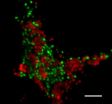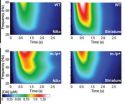(Press-News.org) Most emerging infectious diseases of humans come from animals. International health agencies monitor these diseases, but they do so only for humans and livestock, not for companion dogs and cats. A new study recommends a global system is needed to monitor infectious diseases of companion dogs and cats.
The study, led by Michael Day, Professor of Veterinary Pathology in the School of Veterinary Sciences at the University of Bristol and published online in Emerging Infectious Diseases, lists key infectious diseases that may be transmitted between dogs and cats and man ('zoonotic diseases'). It is well recognised that most of the major new diseases of mankind will have an animal origin and dogs and cats are a potential source of such 'emerging diseases'.
The World Small Animal Veterinary Association (WSAVA) One Health Committee, which promotes the closer integration of human and animal healthcare ('One Health') in collaboration with the US Centers for Disease Control and Prevention (CDC), the World Organisation for Animal Health (OIE) and the World Health Organization (WHO), recommends in the paper a co-ordinated global disease monitoring system is established for veterinarians who work in small companion animal practice.
However, development of such a scheme would require significant political will, scientific application and financial support that could be achieved through a public-private partnership. The knowledge gained through surveillance would permit more effective global control of small companion animal zoonoses and so reduce the risks inherent within this most fundamental of human relationships.
Canine rabies virus infection, one of the diseases listed in the paper, is estimated to kill a minimum of 55,000 people in Africa and Asia each year.
Michael Day, Professor of Veterinary Pathology in the School of Veterinary Sciences, said: "The number of small companion animals is significant. For example there are an estimated eight to ten million dogs living in up to 31 per cent of UK homes and in the USA, 72 million dogs in 37 per cent of homes.
"In developed countries the relationship between man and dogs and cats has deepened, with these animals now closely sharing the human indoor environment. The benefits of pet ownership on human health, well-being and development are unquestionable, but as dogs and cats have moved from the barn, to the house, to the bedroom, the potential for disease spread to humans increases. Control of diseases among dogs and cats is a good way to prevent spread to humans."
Small companion animals, most typically dogs and cats, are kept by people for companionship or a range of utilitarian purposes. Dogs and cats have a close relationship with their human owners and play an important role in the cultures of both developed and developing communities. The social and societal benefits of pet ownership are significant, with dogs now participating in programmes in institutions such as schools, prisons and hospitals, in addition to their role in family life.
In human, livestock and wildlife heath there are programmes of active surveillance for infectious disease, which monitor the global distribution and movement of key infectious agents. For example, the WHO monitors human influenza virus infection through a network of 111 centres in 83 countries. In contrast, there is no such monitoring for the infections that may be transmitted between small companion animals and man.
###
Paper: Surveillance of zoonotic infectious diseases transmitted by small companion animals, Day M J, Breitschwerdt E, Cleaveland S, Karkare U, Khanna C, Kirpensteijn J, Kuiken T, Lappin MR, McQuiston J, Mumford E, Myers T, Palatnik-de-Sousa CB, Rubin C, Takashima G, Thiermann A. Emerging Infectious Diseases, volume 18, issue 12, December 2012.
END
Enjoying Spanish participation, an international group of researchers have analysed the most recent history of the Alhama de Murcia fault. They discovered that it has experienced six major earthquakes above 7 on the Richter scale. According to the scientists, this provides "convincing evidence" that the maximum earthquake magnitudes in the area are higher than originally thought.
Since 2001, researchers from the Universities of Barcelona, Leon, Complutense de Madrid (UCM), Coimbra (Portugal), Aahus (Denmark) and the National Autonomous University of Mexico have been working ...
This press release is available in German.
Microbiologists and geochemists from the Max Planck Institute for Marine Microbiology, along with their colleagues from Vienna and Mainz, show that marine methane oxidation coupled to sulfate respiration can be performed by a single microorganism, a member of the ancient kingdom of the Archaea, and does not need to be carried out in collaboration with a bacterium, as previously thought. They published their discovery as an article in the renowned scientific journal Nature.
Vast amounts of methane are stored under the ocean ...
It is often assumed that those on low incomes and with low levels of education are overly represented in the major increase in obesity of recent decades.
A new thesis from the Lund University School of Economics and Management, Sweden, shows that obesity is increasing across all social groups and that we need to look at factors other than socioeconomic status to understand and solve one of the major public health concerns of the Western world.
Åsa Ljungvall, a researcher in economics at the Lund University School of Economics and Management, has studied the increase ...
A new study has found Acute Myeloid Leukaemia (AML) patients given a new type of 'smart drug' in addition to chemotherapy treatment are 22 per cent less likely to relapse and around 13 per cent less likely to die from their disease. The results are from a major phase III Cancer Research UK-funded trial led by Cardiff University.
Of the 1,115 patients who took part in the trial, 68 per cent relapsed on the new treatment within three years, compared with 76 per cent of those who had the standard treatment. And 25 per cent were still alive after three years, compared with ...
Those individuals who work outdoors with resultant sun exposure are at increased risk for non-melanoma skin cancers, such as squamous cell carcinoma and basal cell carcinoma. Manigé Fartasch shows that the connection between occupational UV exposure and squamous cell carcinoma is now well-established in her review article in issue 43 of Deutsches Ärzteblatt International (Dtsch Arztebl Int 2012; 109(43): 715−20).
The results are less clear for basal cell carcinoma, another form of non-melanoma skin cancer. Skin cancers caused by UV light have not yet been considered ...
Delivery at any time before the 39th week of gestation increases the risk of postnatal problems and mortality. A team of authors headed by Christian F. Poets has analyzed mortality and morbidity data from epidemiological studies of infants born between two and six weeks preterm, comparing them with infants born at full term. They present their findings in issue 43 of Deutsches Ärzteblatt International (Dtsch Arztebl Int 2012; 109(43): 721−6).
As a rule, elective Cesarean sections are performed somewhat before full term, in order to prevent spontaneous delivery. However, ...
CHICAGO (November 12, 2012) – In the December issue of Infection Control and Hospital Epidemiology, the journal of the Society for Healthcare Epidemiology of America, guidelines have been proposed by epidemiologists from Beaumont Health System to reduce the risk of infection from contaminated gels. The recommendations are based on the authors' own experiences with an outbreak traced to contaminated ultrasound transmission gel.
In December 2011, researchers uncovered an unusual cluster of Pseudomonas aeruginosa in a cardiovascular surgery intensive care unit during routine ...
CHAPEL HILL, N.C. – Last year a clinical trial of L-DOPA -- a mainstay of Parkinson's disease therapy -- was launched for Angelman syndrome, a rare intellectual disorder that shares similar motor symptoms such as tremors and difficulty with balance. The clinical trial is based on a 10-year-old case report showing benefit with the drug, but few studies since have explored the neurological justification for using L-DOPA to treat parkinsonian features in Angelman syndrome.
New research from the University of North Carolina School of Medicine, conducted in animal models ...
CHICAGO (November 12, 2012) – According to a new study published online today, most patients at risk for healthcare-associated infections (HAIs) agree that healthcare workers should be reminded to wash their hands, but little more than half would feel comfortable asking their physicians to wash. The study is published in the December issue of Infection Control and Hospital Epidemiology, the journal of the Society for Healthcare Epidemiology of America. The study points to the need for patient empowerment to improve hand hygiene of healthcare workers.
Researchers from ...
PHILADELPHIA — The simultaneous inhibition of two separate and seemingly unrelated pathways could potentially provide an effective treatment for women with triple-negative breast cancer, according to results of two studies published in the November issue of Cancer Discovery, a journal of the American Association for Cancer Research.
Triple-negative breast cancers do not express three common targets of breast cancer treatments: the estrogen receptor, progesterone receptor and HER2/neu. As a result, women with triple-negative breast cancer have few treatment options. In ...



